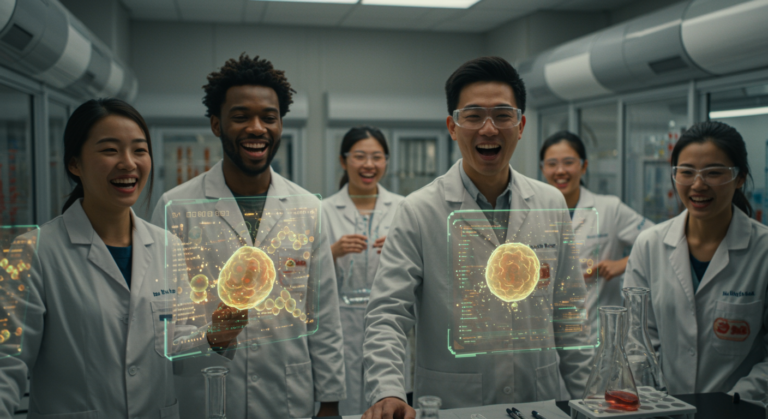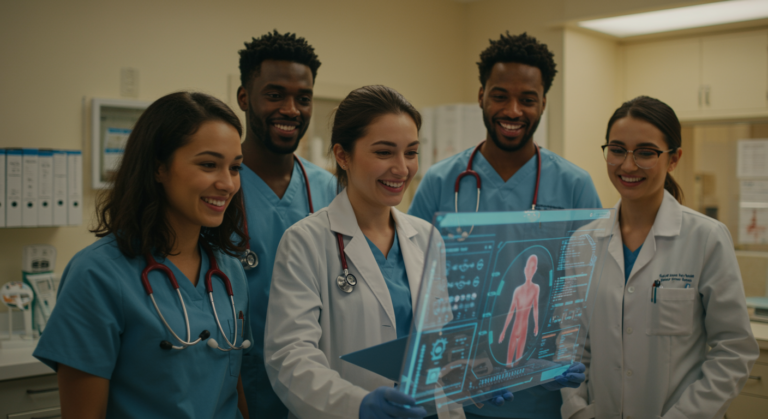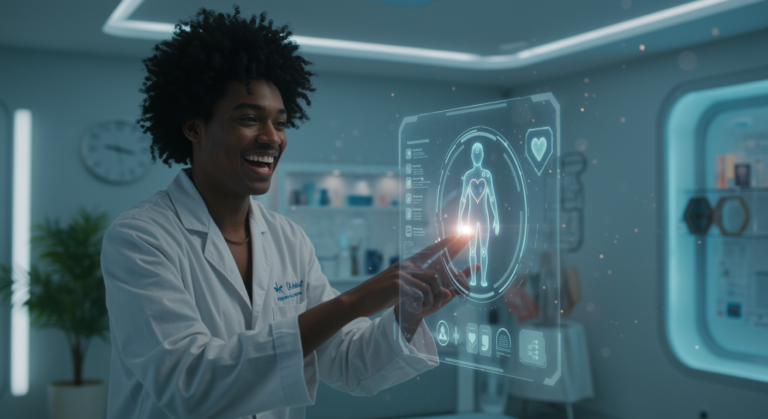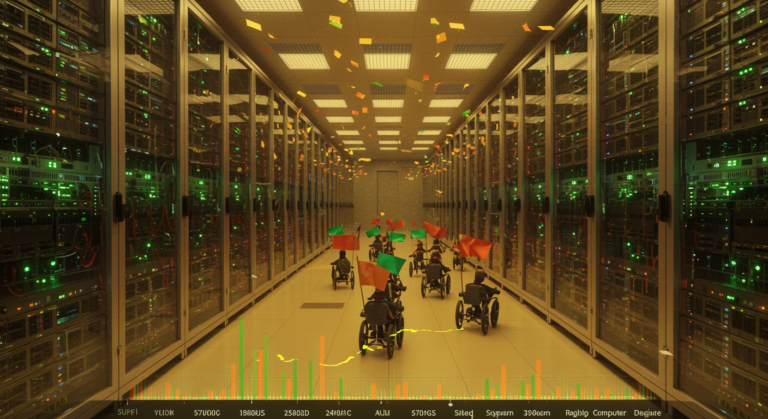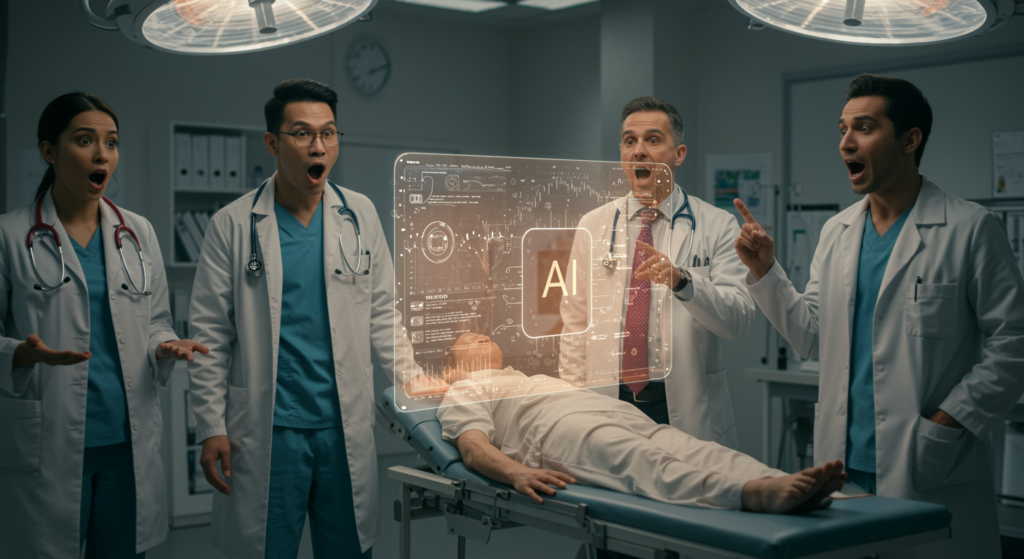
Innovative AI Outperforms Human Physicians in Medical Exam
The Rise of Clinical AI: Outperforming Humans in Medical Exams
Imagine a world where clinical AI systems don’t just assist doctors—they excel in ways that redefine medical expertise. Clinical AI, like the Semantic Clinical Artificial Intelligence (SCAI) from the University at Buffalo, is now eclipsing human performance on rigorous tests such as the USMLE, pushing the boundaries of evidence-based medicine. This isn’t science fiction; it’s happening today, with AI achieving scores that leave most physicians in the dust.
Have you ever wondered if technology could enhance something as personal as a doctor’s intuition? Well, recent studies show clinical AI systems scoring 95.2% on USMLE Step 3, far outpacing the 90.5% from advanced models like GPT-4 Omni and the majority of human doctors. By weaving vast medical knowledge into precise, reasoned responses, clinical AI is becoming a game-changer for healthcare decision-making.
Clinical AI’s Breakthrough on the USMLE
The USMLE stands as the ultimate benchmark for medical readiness, testing everything from foundational science to real-world patient care. Clinical AI tools, such as SCAI, are not only passing these exams—they’re dominating them. In trials, SCAI hit an impressive 95.2% on Step 3, a level that exceeds what most human physicians achieve and sets a new standard in the field.
Let’s break it down: Step 1 focuses on basic sciences, Step 2 dives into clinical knowledge, and Step 3 evaluates independent practice. What makes clinical AI stand out is its ability to process and apply information faster than any human, drawing from endless data sources to deliver accurate, evidence-backed answers. Dr. Peter L. Elkin, a leading expert in biomedical informatics, describes this as a shift from simple tools to true partners in medicine, as highlighted in recent reports.
- Step 1: Covers core scientific principles, where clinical AI shines by recalling intricate details instantly.
- Step 2: Tests patient care scenarios, with AI providing nuanced, data-driven insights that rival experienced doctors.
- Step 3: Demands independent judgment, yet clinical AI outperforms by integrating guidelines and evidence seamlessly.
If you’re a medical professional, this might raise questions: Could clinical AI be the ally you’ve been missing in complex cases? By automating routine analysis, it frees up time for what humans do best—building patient relationships.
Comparing Clinical AI to Human Physicians
When it comes to diagnostics and decision-making, clinical AI is pulling ahead. Independent studies reveal that clinical AI reaches up to 90% accuracy in general diagnostics, compared to 74%-76% for human doctors relying on traditional methods. In treatment recommendations, it aligns with physician choices about 68% of the time, and in the rest, experts often find its suggestions more refined.
Take a hypothetical scenario: A patient with ambiguous symptoms arrives in the ER. A human doctor might miss subtle patterns, but clinical AI, trained on massive datasets, spots them quickly. Here’s a quick overview in the table below, showing how clinical AI edges out human performance across key metrics.
| Metric | Clinical AI Performance | Human Physician Performance |
|---|---|---|
| USMLE Step 3 Score | 95.2% (SCAI) 90.5% (GPT-4 Omni) |
Below 95% (majority) |
| Diagnostic Accuracy | Up to 90% | 74%-76% |
| Treatment Decision Alignment | 68% (matched, with superior alternatives in others) | 100% (baseline) |
| Reasoned Explanations | Strong evidence-based logic | Varies by experience |
What if we used clinical AI not as a replacement, but as a supportive tool? This approach could minimize errors and boost confidence, especially in high-stakes environments.
Why Clinical AI Excels in Evidence-Based Reasoning
The secret to clinical AI’s success lies in its advanced reasoning capabilities. Unlike basic databases, clinical AI synthesizes patient data, research, and guidelines to offer context-aware advice that enhances human judgment. This means it doesn’t just regurgitate facts—it thinks through problems, much like a seasoned physician.
Key Benefits of Integrating Clinical AI
- Delivers up-to-date evidence to support decisions, reducing the risk of outdated practices.
- Targets complex cases, like rare diseases, where it can flag potential issues humans might overlook.
- Allows doctors to prioritize empathy and communication, turning consultations into more meaningful interactions.
- Provides consistent, unbiased insights across diverse scenarios, as noted in several studies.
For instance, in a busy clinic, clinical AI could quickly analyze symptoms and suggest tests, giving doctors more time to connect with patients. It’s an actionable strategy: Start by incorporating AI tools in routine reviews to see immediate improvements.
Real-World Impact of Clinical AI on Patient Care
Beyond exams, clinical AI is making waves in actual healthcare settings. In trials for conditions like pneumonia or heart failure, it’s boosted diagnostic accuracy by several points, often exceeding 80%. When paired with human expertise, clinical AI doesn’t just perform—it elevates overall care.
Building a Future with Physician-AI Teams
Experts agree that clinical AI works best as an augmentation tool, not a standalone solution. Picture a collaborative setup where AI handles data crunching while doctors focus on the human elements. As Dr. Peter L. Elkin puts it, “It’s like having an extra set of eyes that reasons alongside you.”
This synergy could transform healthcare efficiency, but how do we get there? Simple steps include training programs that teach doctors to use clinical AI effectively, ensuring it’s integrated ethically and responsibly.
Navigating Challenges with Clinical AI
Of course, with great potential comes great responsibility. Issues like the “black box” problem—where AI’s decision-making isn’t fully transparent—can raise ethical flags. We must address these to maintain trust in clinical AI systems.
- Enhance transparency so recommendations are explainable and accountable.
- Protect patient privacy through strict data protocols.
- Ensure human oversight to catch any biases in AI outputs.
- Regularly update and validate models on diverse populations.
Think about it: What if an AI error occurs? That’s why ongoing oversight is crucial, blending technology with human wisdom to safeguard patient outcomes.
Wrapping Up: Embracing Clinical AI in Modern Healthcare
As clinical AI continues to outperform in exams and real-world applications, it’s clear we’re entering an exciting era of medicine. This technology isn’t here to replace doctors—it’s designed to empower them, leading to safer, more efficient care.
From reducing errors in diagnostics to fostering better decision-making, the possibilities are vast. What are your thoughts on this evolution? Share your experiences in the comments, explore more on AI in healthcare, or check out related articles to dive deeper.
References
- Inside Precision Medicine. “New AI Tool Outperforms Most Human Physicians on U.S. Medical Licensing Examination.” Link
- News-Medical. “AI Outperforms Doctors in Diagnostics but Falls Short as a Clinical Assistant.” Link
- Inc. “An AI Outperformed Human Doctors in a New Clinical Study—and It’s Humble.” Link
- Stanford Medicine. “Physician Decision-Making Chatbot.” Link
- ABC7 News. “Artificial Intelligence Chatbots Outperform Human Doctors.” Link
- JAMA Network. “AI in Medical Diagnostics.” Link
- Ry Rob. “AI Article Writer.” Link
- University at Buffalo. “AI in Evidence-Based Medicine.” Link
clinical AI, medical exam, USMLE, physician performance, evidence-based medicine, AI in healthcare, diagnostic accuracy, AI vs human doctors, medical licensing exams, healthcare innovation

